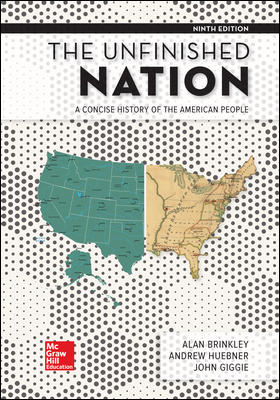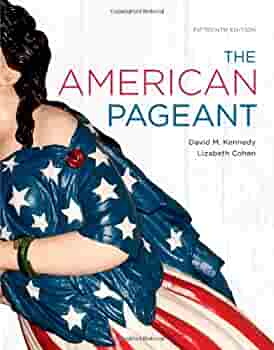Description
Test Bank For The Unfinished Nation A Concise History of the American People 9Th Edition By Alan Brinkley
The Unfinished Nation, 9e (Brinkley)
Chapter 2 Transplantations and Borderlands
1) Which of the following does NOT describe the site chosen for the Jamestown settlement?
A) It was low and marshy and subject to outbreaks of malaria.
B) It was established inland because that was believed to add comfort and stability.
C) It bordered the territories of powerful Indian tribes.
D) It was located on a peninsula.
E) It was inaccessible by ship.
Answer: E
Topic: The Early Chesapeake
Learning Objective: Contrast patterns of settlement and expansion in the Chesapeake with those in New England.
Bloom’s: Remember
Accessibility: Keyboard Navigation
2) Early on, the Jamestown colonists focused primarily on
A) the long-term success of the settlement.
B) building a family-centered community.
C) developing peaceful relations with the Indians in the area.
D) the search for gold and other exports.
E) converting the local Indians to Christianity.
Answer: D
Topic: The Early Chesapeake
Learning Objective: Contrast patterns of settlement and expansion in the Chesapeake with those in New England.
Bloom’s: Remember
Accessibility: Keyboard Navigation
3) Captain John Smith helped the Jamestown settlement survive by
A) waging all-out war with the local Indians.
B) dividing decision-making authority among the colonists to improve morale.
C) imposing work and order on the colonists.
D) introducing tobacco to the colonists.
E) importing African slaves to rebuild the fort.
Answer: C
Topic: The Early Chesapeake
Learning Objective: Contrast patterns of settlement and expansion in the Chesapeake with those in New England.
Bloom’s: Remember
Accessibility: Keyboard Navigation
4) The “starving time” in Jamestown during the winter of 1609–1610 was partly the result of
A) a barricade set up by the Indians, which kept the colonists from hunting and cultivating food inland.
B) the extermination of the Indians who used to grow crops.
C) an influx of rats from settlers’ ships that ate much of the stored grains.
D) a drought that led to crop failures.
E) the sinking of the colonists’ supply ship in the Atlantic.
Answer: A
Topic: The Early Chesapeake
Learning Objective: Contrast patterns of settlement and expansion in the Chesapeake with those in New England.
Bloom’s: Understand
Accessibility: Keyboard Navigation
5) The first profitable economic development in Jamestown resulted from
A) the discovery of gold and silver.
B) fur trade with the Indians.
C) the production of tobacco.
D) development of fisheries and lumber.
E) the cultivation of cotton.
Answer: C
Topic: The Early Chesapeake
Learning Objective: Contrast patterns of settlement and expansion in the Chesapeake with those in New England.
Bloom’s: Remember
Accessibility: Keyboard Navigation
6) The cultivation of tobacco around Jamestown resulted in all the following EXCEPT
A) the importation of tobacco seeds from the West Indies.
B) the search for new sources of labor.
C) rising prosperity for the colony.
D) improved relations with the local Indians.
E) the expansion of European settlement into the interior.
Answer: D
Topic: The Early Chesapeake
Learning Objective: Contrast patterns of settlement and expansion in the Chesapeake with those in New England.
Bloom’s: Understand
Accessibility: Keyboard Navigation
7) The Virginia Company developed the “headright system” to
A) attract new settlers to the colony.
B) discourage poor people from moving to the colony.
C) require families to migrate together.
D) raise revenue from the sale of land.
E) cause conflict among the neighboring Indian tribes.
Answer: A
Topic: The Early Chesapeake
Learning Objective: Contrast patterns of settlement and expansion in the Chesapeake with those in New England.
Bloom’s: Remember
Accessibility: Keyboard Navigation
8) Which of the following statements best characterizes the first years of Jamestown’s existence?
A) A majority of its colonists enjoyed significant economic success.
B) The settlement was often assaulted by Spanish invaders.
C) The settlement was notable for its peaceful relations with local Indians.
D) The settlement was notable for its toleration of political freedom.
E) The settlement survived despite an enormous loss of life.
Answer: E
Topic: The Early Chesapeake
Learning Objective: Contrast patterns of settlement and expansion in the Chesapeake with those in New England.
Bloom’s: Remember
Accessibility: Keyboard Navigation
9) When the House of Burgesses was created in Virginia in 1619,
A) it gave settlers full political control of their colony.
B) landowning women colonists were allowed to vote.
C) colonists were given a share of local political representation.
D) it put an end to a violent uprising by disgruntled colonists.
E) it recommended that Virginia declare independence from England.
Answer: C
Topic: The Early Chesapeake
Learning Objective: Contrast patterns of settlement and expansion in the Chesapeake with those in New England.
Bloom’s: Remember
Accessibility: Keyboard Navigation
10) The first blacks imported to Virginia in 1619
A) may have been considered indentured servants by the colonists.
B) sparked an immediate rapid stream of African slaves to the British colonies.
C) were preferred to European indentured servants.
D) were subject to the Virginia Slave Codes.
E) arrived as independent landowners.
Answer: A
Topic: The Early Chesapeake
Learning Objective: Contrast patterns of settlement and expansion in the Chesapeake with those in New England.
Bloom’s: Remember
Accessibility: Keyboard Navigation
11) The Powhatan Indian Pocahontas
A) married Englishman John Smith and traveled to England with him.
B) was kidnapped by John Rolfe as a means of forcing the Powhatans to teach the English how to grow tobacco.
C) inspired a debate in England about the possibility of assimilating Indians into English culture.
D) was the cause of a war between the Powhatan Indians and Virginian colonists.
E) refused to convert to Christianity but managed to create a blending of native Christian customs into a hybrid religion.
Answer: C
Topic: The Early Chesapeake
Learning Objective: Contrast patterns of settlement and expansion in the Chesapeake with those in New England.
Bloom’s: Remember
Accessibility: Keyboard Navigation
12) Warfare between Englishmen and Powhatan Indians in Virginia
A) continued without interruption until the early eighteenth century.
B) was first triggered by the kidnapping of Pocahontas.
C) was primarily a result of religious tensions between natives and settlers.
D) was uncommon until the early eighteenth century.
E) included an Indian attack on Jamestown that killed hundreds of colonists.
Answer: E
Topic: The Early Chesapeake
Learning Objective: Contrast patterns of settlement and expansion in the Chesapeake with those in New England.
Bloom’s: Remember
Accessibility: Keyboard Navigation
13) The Virginia Company
A) never sanctioned military action against the Native Americans of Virginia.
B) deeply opposed the importation of Africans to the colonies.
C) was absorbed by the crown because it was becoming too powerful.
D) had its charter revoked by James I.
E) never managed to turn a reliable profit in its Virginia colony.
Answer: D
Topic: The Early Chesapeake
Learning Objective: Contrast patterns of settlement and expansion in the Chesapeake with those in New England.
Bloom’s: Remember
Accessibility: Keyboard Navigation
14) In its beginning, the Maryland colony
A) experienced tremendous warfare with local Indians.
B) allowed no Protestant settlers.
C) was created partly as a refuge for English Catholics.
D) was led by Captain John Smith.
E) experienced considerable conflict with nearby French settlers.
Answer: C
Topic: The Early Chesapeake
Learning Objective: Contrast patterns of settlement and expansion in the Chesapeake with those in New England.
Bloom’s: Remember
Accessibility: Keyboard Navigation
15) Which of the following statements regarding Sir William Berkeley is FALSE?
A) He was a dominant political figure in Virginia for more than three decades.
B) He encouraged Virginia to develop westward.
C) His relations with Indians were violent and bloody.
D) He extended political representation for frontier settlers.
E) He sent explorers across the Blue Ridge Mountains.
Answer: D
Topic: The Early Chesapeake
Learning Objective: Contrast patterns of settlement and expansion in the Chesapeake with those in New England.
Bloom’s: Remember
Accessibility: Keyboard Navigation





Be the first to review “Test Bank For The Unfinished Nation A Concise History of the American People 9Th Edition By Alan Brinkley”